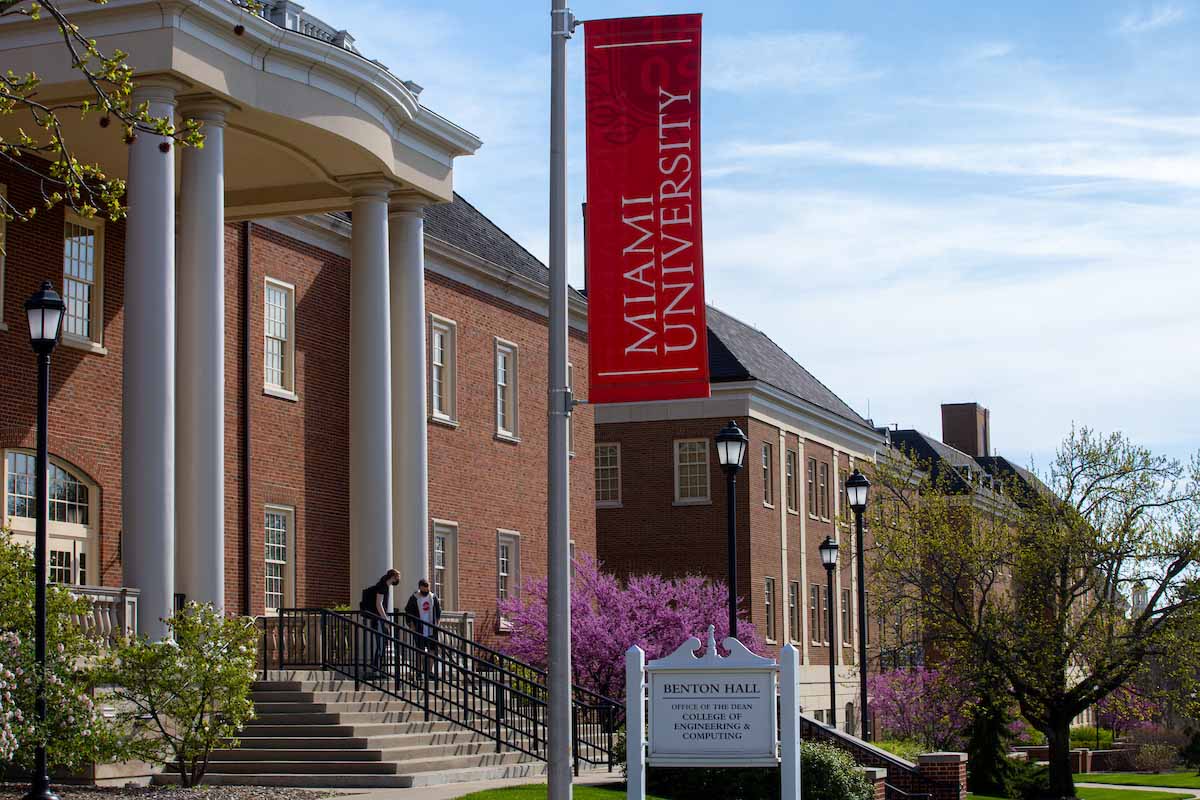Miami supports Intel’s investment in Ohio by developing talent pipeline
University’s STEM and business training prepares students for success with Intel and beyond: Intel pledged an additional $100 million toward partnerships with educational institutions to build a pipeline of talent and bolster research programs in the region.

Miami supports Intel’s investment in Ohio by developing talent pipeline
Miami University joins higher education institutions around the state in supporting Intel Corp’s $20 billion investment in Ohio. The company announced Friday that it will open two new semiconductor fabrication plants in the state that will create tens of thousands of jobs and make Ohio a magnet to attract talent and business from around the world.
“It is exciting to see Intel recognize the talent that calls Ohio home,” Miami University President Gregory P. Crawford said. “Having this facility in our backyard will be transformative for our students and alumni. We look forward to educating the talent that will be so vital for this incredible project. We are extremely grateful to Governor Mike DeWine and our State leaders who were instrumental in bringing Intel to our state.”
As the largest single private-sector investment in Ohio history, the initial phase of the project is expected to create 3,000 Intel jobs and 7,000 construction jobs over the course of the build and support tens of thousands of additional long-term jobs across a broad ecosystem of suppliers and partners. To support the development of the new site, Intel pledged an additional $100 million toward partnerships with educational institutions to build a pipeline of talent and bolster research programs in the region.
It is estimated that semiconductors will become a major Ohio export, helping add $2.8 billion annually to Ohio’s gross state product.
“At Miami University, we believe that engineering and computer science is a force for good,” said Beena Sukumaran, dean of the College of Engineering and Computing (CEC). “The investment that Intel has made in Ohio is an investment in our young engineers and computer scientists who are internally motivated to solve society’s toughest problems. Our graduates are well-versed to address the needs of the semiconductor industry through our curriculum and the experiential learning opportunities we provide.”
Miami leaders said the university is excited for the opportunities the landmark investment will make possible for its 17,000 undergraduate and 2,300 graduate students.
Miami University has played a leading role in the state in fostering the STEM teacher education pipeline, which will be critical for ensuring the needed workforce for the new investment. The university’s Computer Science faculty are collaborating with colleagues in the Department of Teacher Education to develop a statewide curriculum to meet the state’s new computer science requirement for all teacher education candidates and the university’s Robert Noyce Teacher Scholarship Program is an NSF-funded initiative that provides funding for students to become STEM educators.
“Our graduates’ solid technical curriculum, combined with Miami’s high-quality liberal arts emphasis, prepares well-rounded leaders who are innovators and trailblazers,” Sukumaran said. “In addition, our faculty are also excited about Intel’s investment in Ohio because of the contributions they can make through research and workforce development to benefit Intel and other manufacturing facilities.”
Jenny Darroch, dean of the Farmer School of Business, echoed this excitement.
“Miami alumni succeed across industries. Among graduates from FSB alone, you’ll find CEOs of Fortune 500 companies, entrepreneurs creating new jobs, and pioneers of new technologies,” Darroch said. “The opportunities provided by Intel’s investment in Ohio give students, faculty, and alumni the chance to demonstrate what they’ve learned here and live out their commitment to taking on challenges and innovating new approaches to solve age-old problems.”
Intel has said it plans to make significant investments over the next decade in partnership with Ohio universities, community colleges, and the U.S. National Science Foundation. The partnerships will help drive research and create semiconductor-specific curricula for two-year and four-year degree programs.
“With our strong and diverse liberal arts curriculum, the College of Arts and Science prepares Miami’s largest cohort of graduates every year,” said Chris Makaroff, dean of Miami’s College of Arts and Science. “We are committed to helping all of our students discover their passions that will set them on the path to prosperous careers that they love. This investment by Intel is an incredible opportunity for our students, whether their majors are in Physics, Professional Writing, Chemistry, Data Analytics, or dozens more.”
Miami consistently receives national recognition for its undergraduate education as well as career return on investment. It is consistently ranked among the top 40 “Best Value Public Colleges” by Princeton Review and in the top 50 national public universities by U.S. News & World Report.
Miami recently was ranked No. 2 in the nation for skilled technical talent based on students’ technical skills in CodeSignal’s first annual ranking of universities. Miami is topped only by the Massachusetts Institute of Technology. Miami CEC’s overall success rate for job placement was 96.7%, according to Miami’s Institutional Research’s “First Destinations of 2019-2020 Miami University Graduates” report.
Miami’s software engineering degree program was ranked No. 6 in the country and “Best in the Southeast” and its bachelor of science in game + simulation was ranked No. 6 in the country and the Best for Game Art.
“[The] investment marks another significant way Intel is leading the effort to restore U.S. semiconductor manufacturing leadership,” Intel CEO Pat Gelsinger said in a press release.
“Intel’s actions will help build a more resilient supply chain and ensure reliable access to advanced semiconductors for years to come. Intel is bringing leading capability and capacity back to the United States to strengthen the global semiconductor industry. These factories will create a new epicenter for advanced chipmaking in the U.S. that will bolster Intel’s domestic lab-to-fab pipeline and strengthen Ohio’s leadership in research and high tech.”